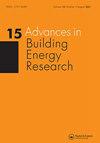保温毯对手术室通风系统性能影响的数值研究
IF 2.5
Q2 CONSTRUCTION & BUILDING TECHNOLOGY
引用次数: 2
摘要
摘要患者加温是预防手术中体温过低的有效方法。低温会增加术后感染、出血、输血需求、延长术后恢复、药物代谢持续时间和血管收缩的风险。尽管保温毯的使用解决了患者核心体温下降的问题,但人们仍然担心,这些保温毯散发的热量会干扰通风系统提供的清洁空气,从而增加空气中颗粒物的污染水平。本研究的主要目的是对手术室中使用保温毯对两种常见通风系统(单向流和混合通风)性能的影响进行数值研究。在手术室模拟了使用强制空气和导电保温毯对携带细菌的颗粒分布和气流行为的影响。结果表明,应用强制空气加温毯显著提高了伤口区域和手术布下的平均空气温度。因此,在手术期间,强制空气加温毯在加温患者方面可以比导电毯更有效。然而,使用受污染的强制空气加温毯导致伤口表面的污染浓度显著增加。本文章由计算机程序翻译,如有差异,请以英文原文为准。
Numerical investigation of the impact of warming blankets on the performance of ventilation systems in the operating room
ABSTRACT Patient warming is an efficient approach to preventing hypothermia during surgeries. Hypothermia increases the risk of postoperative infections, bleeding, transfusion demand, prolonging postoperative recovery, drug metabolism duration and vasoconstriction. Although the use of warming blankets addresses the problem of a decrease in a patient’s core body temperature, concern remains that the heat emitted by these warming blankets can disturb the supplied clean air by the ventilation system and thus increase the contamination level of airborne particles. The main purpose of this study is to numerically investigate the impact of using warming blankets on the performance of two common ventilation systems – unidirectional flow and mixing ventilation – in an operating room. The effect of using forced-air and conductive warming blankets on the distribution of bacteria-carrying particles and airflow behaviour were simulated in the operating room. The results showed that applying the forced-air warming blanket considerably increased the average air temperature at the wound area and under the surgical drape. Thus, the forced-air warming blanket can be more effective than the conductive blankets in warming the patient during the surgery. However, using the contaminated forced-air warming blanket resulted in a considerable increase in the contamination concentration at the wound surface.
求助全文
通过发布文献求助,成功后即可免费获取论文全文。
去求助
来源期刊

Advances in Building Energy Research
CONSTRUCTION & BUILDING TECHNOLOGY-
CiteScore
4.80
自引率
5.00%
发文量
11
 求助内容:
求助内容: 应助结果提醒方式:
应助结果提醒方式:


